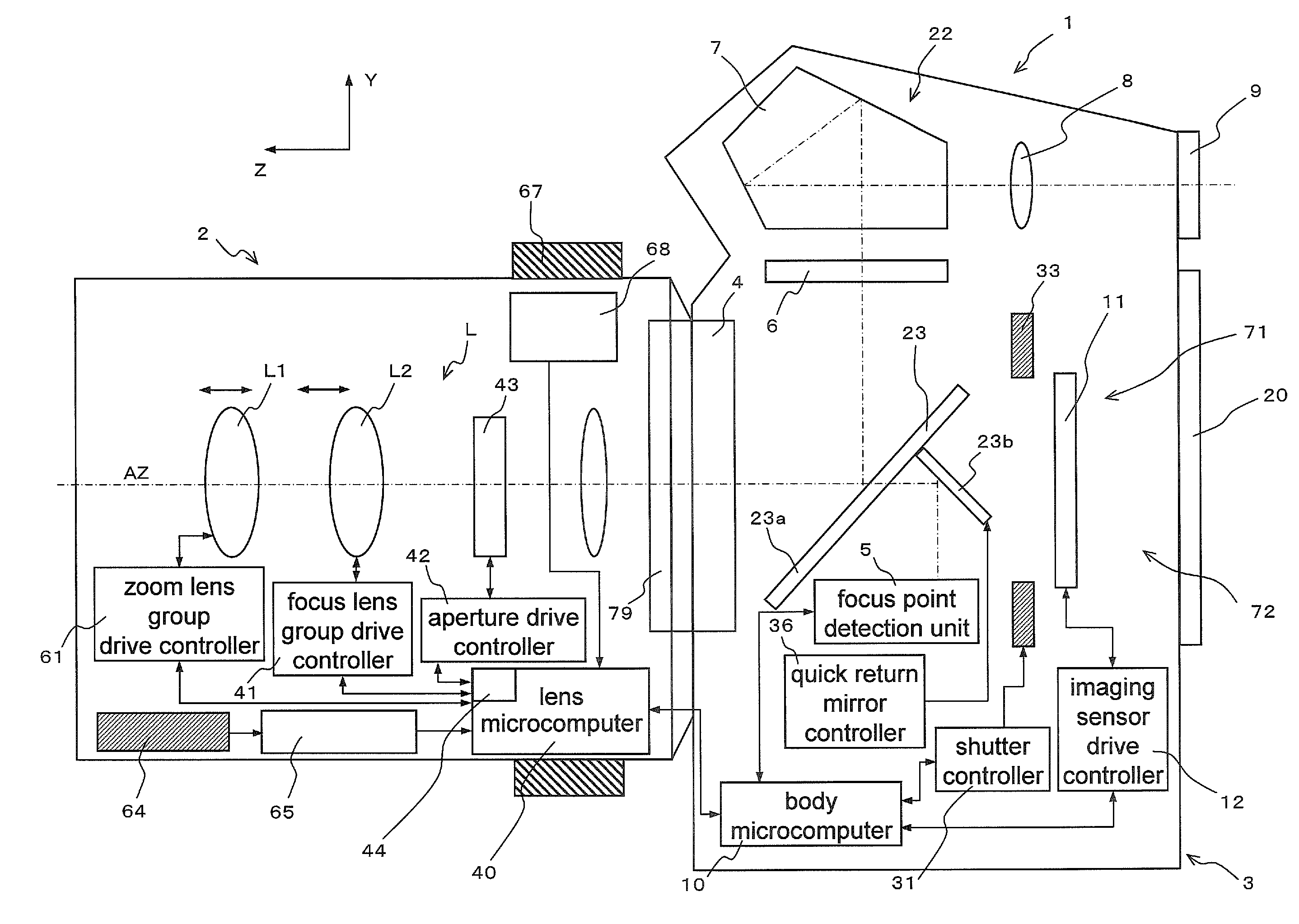Camera body, interchangeable lens unit, and camera system
a technology of interchangeable lenses and camera bodies, applied in television systems, printing, instruments, etc., can solve the problems of difficult use of conventional camera systems and inability to use liquid crystal monitors during imaging
- Summary
- Abstract
- Description
- Claims
- Application Information
AI Technical Summary
Benefits of technology
Problems solved by technology
Method used
Image
Examples
first embodiment
1: Overall Configuration of Camera System
[0081]The overall configuration of the camera system 1 according to a first embodiment will be described through reference to FIGS. 1 to 3. FIG. 1 is a block diagram of the camera system 1. FIG. 2 is a block diagram of a camera body 3. FIGS. 3A and 3B are simplified diagrams the camera body 3, with FIG. 3A being a view of the camera body 3 from above, and FIG. 3B a view of the camera body 3 from the rear.
[0082]As shown in FIG. 1, the camera system 1 is an interchangeable lens type of digital single lens reflex camera system, and is made up mainly of the camera body 3 having the primary function of the digital camera 1, and an interchangeable lens unit 2 that is removably mounted to the camera body 3. The interchangeable lens unit 2 is mounted to a body mount 4 provided to the front face of the camera body 3, via a lens mount 79.
[0083]1.1: Interchangeable Lens Unit
[0084]As shown in FIGS. 1 and 2, the camera body 3 is made up mainly of an imagi...
second embodiment
[0242]There is no problem when the autofocus imaging mode is selected as the focus imaging mode.
[0243]However, if the interchangeable lens unit 2 is compatible with electric manual focus, focusing must be performed by an operation unit on the camera body 3 side. Also, if the focus ring 67 or another such focus operation unit is mounted to the interchangeable lens unit 2, damage to the system must be prevented just as with the electric zoom discussed above.
[0244]In view of this, just as in the first embodiment, a constitution is possible in which focus operation with the cross control key 27 or the focus ring 67 is either activated or inactivated according to whether or not the interchangeable lens unit 2 is compatible with electric focus (more precisely, electric manual focus).
[0245]In the following description, those components having substantially the same function as components in the first embodiment will be numbered the same and will not be described in detail again.
[0246]1: Ov...
third embodiment
[0332]The quick return mirror 23 was used in the first and second embodiments, but if focusing is possible by contrast detection method, the quick return mirror 23 can be eliminated. A camera system 1A according to a second embodiment will be described through reference to FIG. 18. FIG. 18 is a block diagram of the configuration of the camera system 1A. Those components that have substantially the same function as the components shown in FIG. 1 will be numbered the same and will not be described in detail again.
[0333]1: Overall Configuration of Camera System
[0334]In FIG. 18, the camera system 1A is a digital single lens reflex camera system with an interchangeable lens, and mainly comprises a camera body 3A having the main functions of the camera system 1A, and an interchangeable lens unit 2 that is removably mounted to the camera body 3A. The interchangeable lens unit 2 is mounted via a lens mount 79 provided at the rearmost part, to a body mount 4 provided to the front face of the...
PUM
 Login to View More
Login to View More Abstract
Description
Claims
Application Information
 Login to View More
Login to View More - R&D
- Intellectual Property
- Life Sciences
- Materials
- Tech Scout
- Unparalleled Data Quality
- Higher Quality Content
- 60% Fewer Hallucinations
Browse by: Latest US Patents, China's latest patents, Technical Efficacy Thesaurus, Application Domain, Technology Topic, Popular Technical Reports.
© 2025 PatSnap. All rights reserved.Legal|Privacy policy|Modern Slavery Act Transparency Statement|Sitemap|About US| Contact US: help@patsnap.com



